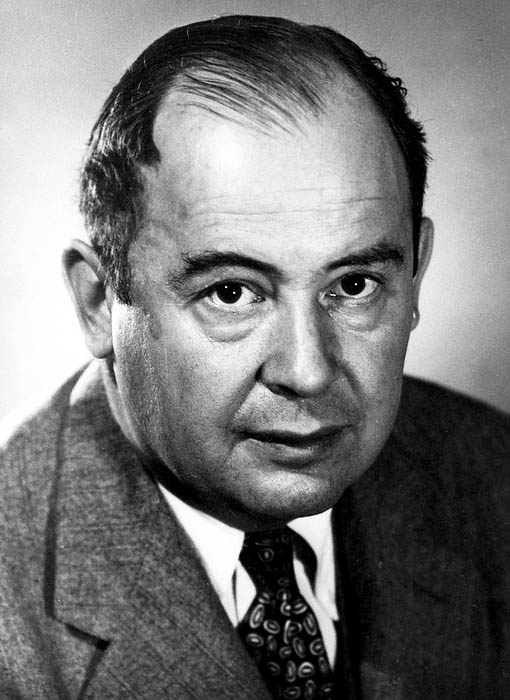SIAM and John von Neumann

SIAM’s John von Neumann Prize is naturally the best-known connection between SIAM and the esteemed mathematician John von Neumann. It was established in 1959 as the “von Neumann Lecture,” with initial monetary contributions from IBM and other organizations. Once those assets were exhausted, SIAM funded all of the award’s expenses and continues to do so.
“Initially, the lecture alternated between someone inside the applied math community and someone from a more applied discipline that used a lot of applied math,” James Crowley, the former executive director of SIAM, explained. “You hence see, for example, some notable economists in the list of former lecturers. Over time, the leadership began to regard this lecture as a flagship prize of SIAM, and the focus changed from alternating between applied mathematicians and users of applied math to recognizing the best in our field.” A few years ago, the Board of Trustees formally recognized this evolution by changing the designation from Lecture to Prize and noting that it is the highest honor that SIAM bestows. The full list of past recipients is available on the prize webpage.
The prize signifies just one of many connections between von Neumann and the SIAM membership. At the 2003 SIAM Conference on Computational Science and Engineering, Gene Golub and Joseph Grcar organized “John von Neumann’s 100th Birthday Celebration Symposium.” Philip J. Davis provided a personal overview of the celebration in a SIAM News article [2] and recounted the remarks of the four speakers: William Aspray [1], Marina von Neumann Whitman [6], Peter Lax [4], and Pete Stewart (the first three talks subsequently appeared in SIAM News in 2005). The presentations collectively served as a rich mix of accounts and anecdotes that captured von Neumann’s personal and mathematical influences throughout the history of computing.
In addition, Grcar has analyzed in illuminating detail [3] what he calls “the first modern paper in numerical analysis” — von Neumann and Herman Goldstine’s study of Gaussian elimination with ideas that are now well known under their modern names, such as condition number and Courant-Friedrichs-Lewy stability criteria [5]. Of course, this research was the initial gust in a mighty storm of rigorous work in numerical computing, much of which was led by SIAM members and published in SIAM journals — notably the SIAM Journal on Numerical Analysis.
In his paper, Grcar also recounts many specifics about the intellectual property dispute that arose in part from Goldstine’s circulation of von Neumann’s “First Draft of a Report on the EDVAC.” This obviously incomplete text was the first description of an architecture for a stored-program computer, with only one reference and von Neumann as its single author. It was written during a time when von Neumann would have been fully cognizant of J. Presper Eckert and John Mauchly’s work with ENIAC — an automatic calculator and predecessor to the programmable EDVAC.
Ananyo Bhattacharya’s new von Neumann biography, The Man from the Future, offers further details and a slightly different perspective. However, the key takeaway is that von Neumann’s report became the legal cannon that crippled Eckert and Mauchly’s plans to commercialize their work. The duo’s firm did ultimately produce the UNIVAC I (UNIVersal Automatic Computer I), a machine that was sold at a loss to the U.S. Department of Commerce to automate the analysis of the 1950 census. In the meantime, von Neumann enjoyed a well-paid consulting assignment with IBM while the patent disputes, the historic question of “Who invented the computer?,” and the dilemmas of public and private rights simmered on for years.
Mauchly went on to serve as the fourth president of SIAM — a critical contribution in SIAM’s embryonic, volunteer-driven early years. He is now largely overlooked in the shadows of von Neumann’s larger and well-deserved reputation.
A different and broader cache of stories from the youthful years of scientific computing is available in SIAM’s “History of Numerical Analysis and Scientific Computing,” which contains fascinating oral histories, articles, and other resources about key players and developments. While many of the modern chapters began with von Neumann and Goldstine’s famous Gaussian elimination paper [5], the story grows richer and more satisfying every day. And SIAM remains the place to follow it.
References
[1] Aspray, W. (2005, March 1). On John von Neumann and his role in the development of the computer. SIAM News, 38(2), p. 7.
[2] Davis, P.J. (2003, May 30). SIAM conference on CS&E: John von Neumann at 100: SIAM celebrates a rich legacy. SIAM News, 36(4), p. 1.
[3] Grcar, J.F. (2011). John von Neumann’s analysis of Gaussian elimination and the origins of modern numerical analysis. SIAM Rev., 53(4), 607-682.
[4] Lax, P. (2005, March 1). John von Neumann: The early years, the years at Los Alamos, and the road to computing. SIAM News, 38(2), p. 9.
[5] Von Neumann, J., & Goldstine, H.H. (1947). Numerical inverting of matrices of high order. Bull. Amer. Math. Soc., 53, 1021-1099.
[6] Von Neumann Whitman, M. (2005, March 1). Life with father. SIAM News, 38(2), p. 8.
About the Author
Paul Davis
Professor Emeritus, Worcester Polytechnic Institute
Paul Davis is professor emeritus of mathematical sciences at Worcester Polytechnic Institute.
Stay Up-to-Date with Email Alerts
Sign up for our monthly newsletter and emails about other topics of your choosing.



